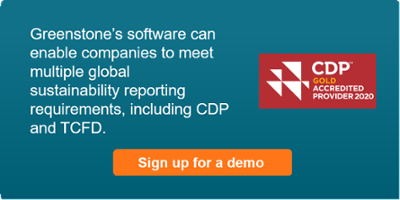EU Taxonomy regulation – key impacts for companies & investors (FAQs)
 Yesterday, the EU Commission’s Taxonomy Regulation entered into law, marking a significant step in sustainable finance. The EU Taxonomy is a classification tool aimed at investors, companies and issuers to better define the environmental performance of economic activities across a wide range of sectors, and will give clarity to the requirements economic activities must meet to be considered “green”.
Yesterday, the EU Commission’s Taxonomy Regulation entered into law, marking a significant step in sustainable finance. The EU Taxonomy is a classification tool aimed at investors, companies and issuers to better define the environmental performance of economic activities across a wide range of sectors, and will give clarity to the requirements economic activities must meet to be considered “green”.
Greenstone recently held a webinar on ‘EU Taxonomy for sustainable finance - key impacts for companies and investors’. As a follow up to this webinar, we have compiled a list of the most frequently asked questions from our audience:
What is the EU Taxonomy?
The EU Taxonomy is a regulatory classification system that helps investors and companies define which economic activities are environmentally sustainable. The regulation also places a reporting obligation on certain companies to disclose how much of their investment is aligned with sustainable activities.
What criteria does an economic activity need to meet to be classified as sustainable?
Firstly, the activity must substantially contribute to at least one of six environmental objectives: Climate Change Mitigation, Climate Change Adaptation, Sustainable Use and Protection of Water and Marine Resources, Transition to a Circular Economy, Pollution Prevention and Control, and the Protection and Restoration of Biodiversity and Ecosystems. Secondly, the activity must not do any significant harm to the other environmental objectives. Thirdly, the activity must comply with minimum social and governance safeguards. Finally, the activity must also comply with technical screening criteria as determined by the EU.
Who does the EU Taxonomy Regulation apply to?
Anyone can use the EU Taxonomy to classify their economic activities as sustainable. However, reporting under the Taxonomy will be a mandatory requirement for three key users: Firstly, financial market participants and issuers offering financial products within the EU (including the UK). Secondly, large companies (with over 500 employees) who are already required to provide a non-financial statement under the EU Non-Financial Reporting Directive (NFRD). Thirdly, EU and Member States when setting public measures, standards or labels for green financial products or green bonds.
What information are users of the Taxonomy required to disclose?
Users of the Taxonomy need to disclose which proportion of their Turnover, Capital Expenditure and Operating Expenditure is associated with environmentally sustainable economic activities. Companies with products and services that are not sustainable will have to make a statement saying the investments do not consider the regulation.
Where and when should users of the Taxonomy disclose?
Large companies should make their disclosures in a non-financial statement within their annual reports or in a dedicated sustainability report during the course of 2022 on Climate Change Mitigation and Adaptation, and during 2023 for all environmental objectives. Financial market participants should disclose in their periodic reports, pre-contractual disclosures and on their websites by 31 December 2021 for Climate Change Mitigation and Adaptation, and by 31 December 2022 for all environmental objectives.
For more information on how Greenstone’s software can enable companies to meet multiple global sustainability reporting requirements, including the EU Taxonomy, contact us or sign up for a software demo.










